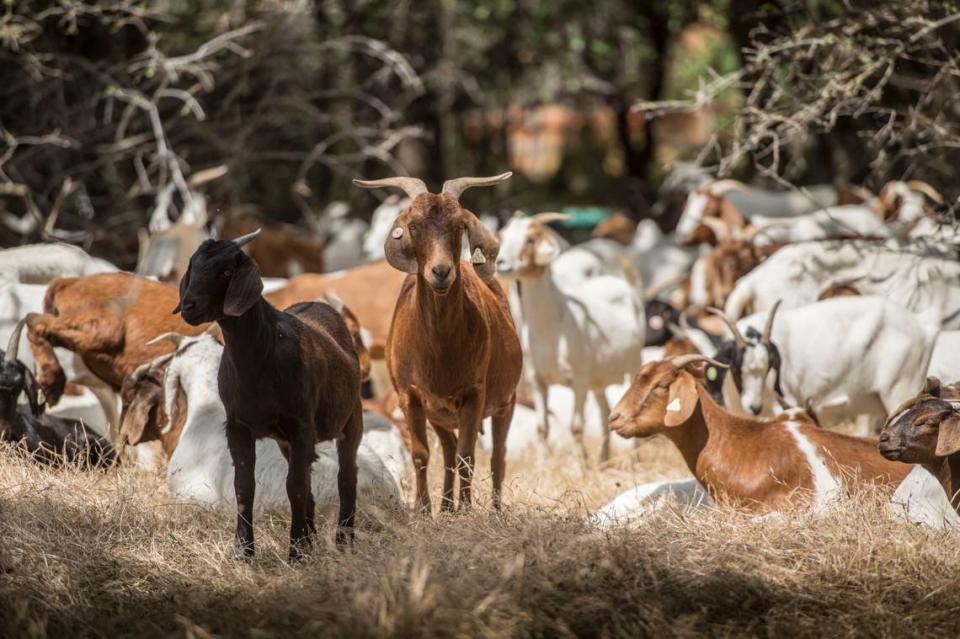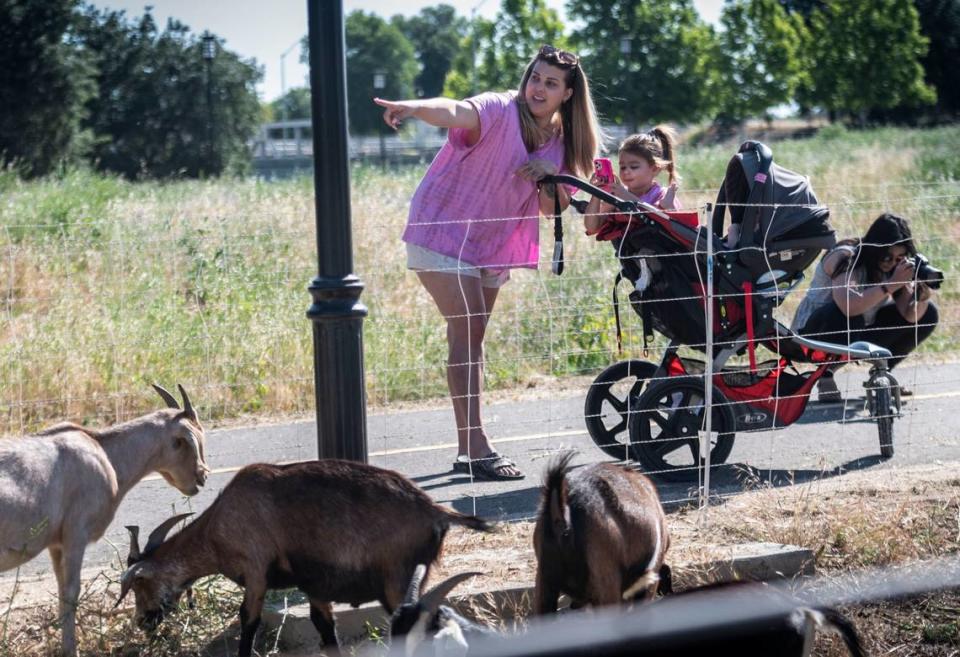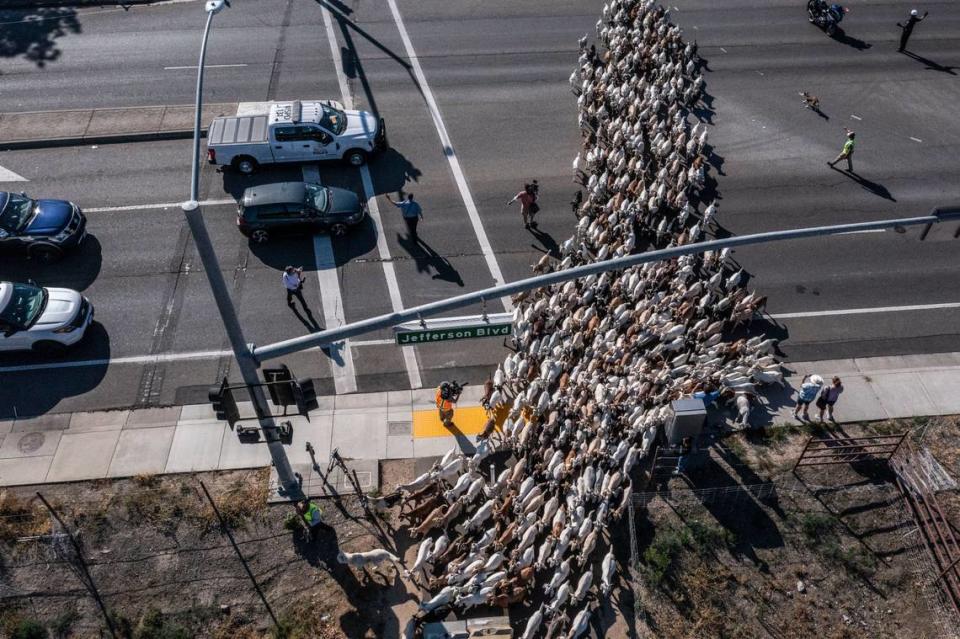Goats grazing in your backyard? This climate solution is gaining ground in California
Climate change is global but the actions we take here in Sacramento play a role in shaping our environmental future. The Sacramento Bee is undertaking a collaboration with you to examine and celebrate bold and ambitious climate actions that have yielded evidence that they’re making progress here and elsewhere. The goal is to engage you and your neighbors in a hopeful discussion about how we can face climate change with urgency and equity.
Drucella Miranda, an educator who designed youth programs, was frustrated with urging others to “do better by the Earth” without putting effort into the same herself. So she turned in a letter of resignation to her job and set her sights on starting a Sacramento area landscaping business — using goats.
It’s not as crazy as it sounds. Though some cities still have policies hostile to grazing businesses, others — including Citrus Heights, Elk Grove and West Sacramento — have contracted goat herds in recent years to graze down overgrowth in parks, schools and other open spaces. City officials cited lower costs, less noise and fewer toxic chemicals compared to other landscaping solutions, and even residents’ enjoyment of having goats around as reasons for doing so.
California labor regulators recently reclassified goat herders, leading to some goat grazing companies sounding the alarm that this method of underbrush clearing may disappear, the Los Angeles Times and other publications reported.
However, the concern over requiring hourly pay for goat herders primarily affects large operations that graze in fire-prone wilderness areas. For urban grazing operations like the one that Miranda wants to start, where herders are already paid by the hour, business is booming.
An operator in San Francisco said they frequently have to turn down requests outside their service area, while Iowa company Goats on the Go said they received so many inquiries that they started a national affiliate network of small operators, including two in California.

A more economic and fun ‘natural solution’
Judy-B., which she said is her full legal name, works as the resident manager for the San Francisco apartment complex she lives in and first brought in goats to clear out vegetation from a yard on the property in 2019.
While traditional landscaping services would have cost more than $2,000 for the 75-foot-by-30-foot yard, San Francisco-based nonprofit City Grazing only charged around $1,250 to have goats graze down the blackberry brambles and other overgrowth, she said. For the less dense vegetation this year, that cost was down to $950.
“It’s environmentally friendly and it is cheaper than hiring a landscaper, so it was actually an easy sell (to the property management company),” she said.
Similarly, the $22,000 that the city of Citrus Heights spent for goats to graze around a middle school and in open spaces was “half of what it would cost for contractors to do the same work,” according to city spokesperson Marisa Brown.
In areas with steep slopes or restrictions on chemical runoff, goat grazing can be the only practical way to clear vegetation, said Aaron Steele, co-founder of Goats on the Go.
The city of Elk Grove, for example, is “restricted from using any chemical or mechanical methods in the creek beds,” spokesperson Kristyn Laurence said. “Therefore using livestock allows us to clear those areas.”
Laurence also noted that the city chose grazing for its positive environmental impact.
Instead of having to haul away clippings after a job, goats turn unwanted vegetation into “immediately bioavailable nutrients for the soil in the form of goat poop,” benefiting trees and native plants in the area, said Genevieve Church, executive director of City Grazing.
The nutrients strengthen the root systems of grasses and plants that remain, helping them store more carbon in the soil, produce more oxygen and improve the air quality in the area, Church said.
Compared to using “big disruptive mechanical equipment” for landscaping, grazing also minimizes erosion and the use of herbicides, Steele said.
“I can’t make huge claims …about how using goats for vegetation control is dramatically cutting the use of fossil fuels and carbon emissions,” Steele said. “(But) if we want to maintain a native landscape and all the benefits that go with that…we have a natural solution to these problems, why aren’t we using it more?”
Finally, the educational value — and simply the delight — of having goats around contribute to their popularity as a grazing solution, operators said.

“A lot of our public clients love having the goats come in because it’s an opportunity for the surrounding community to get together and have a free, safe, fun outdoor activity,” Church said.
City Grazing recently started working with the San Francisco School District, where part of the sell was providing “kids with some access to seeing sustainable land management in action.”
“We’ve put up educational materials, teaching them a little bit about why goat grazing is such a great choice, but they’re also getting the fun and excitement of getting to have goats right next to their schoolyard and getting to watch them there for a week or two at a time,” Church said.
Regulatory challenges but ‘the tide is turning’
Not everything goes smoothly for grazing businesses.
When Miranda contacted 311 in Sacramento to ask about her business plans, she was routed to assistant planner Steffane Lui. Lui told Miranda via email that she reached out to the city’s animal care services and that because “there are no policies or codes in place to regulate this type of business ... at this time the current proposal would not be approved.”
Sacramento has a city ordinance that “generally prohibits the keeping, harboring, or maintaining of livestock on property within the City,” said city spokesperson Tim Swanson. When asked whether the ordinance prohibits bringing goats to a city property as part of a grazing business, Swanson said that “the determination would be made on a case-by-case basis.”
Dealing with city regulations is a problem that experienced operators have also run into.
“Every city kind of interprets their regulations differently,” Steele said. “They all have virtually identical wording, and yet you can go from one city and they’re all in [on targeted grazing], And then you go to another city and they look at the same regulations and say, nope, not allowed at all.”
The solution is to engage with local residents and educate city leadership about grazing, Steele said. The Goats on the Go website highlights the cities of Salem, Oregon, and Dubuque, Iowa, as success stories for when community members or affiliate operators worked with the cities to implement grazing-friendly policies.
“I think that generally the tide is turning and no city wants to be left behind and viewed as the city who is stuck in their ways and not innovative enough to embrace this really great practice,” Steele said.
In the Sacramento area, the cities of Citrus Heights and Elk Grove have both directly contracted goats for grazing, while a spokesperson for Rancho Cordova affirmed that “our municipal code allows grazing animals to be used for weed abatement and property maintenance.”
Local challenges, local solutions
Miranda was drawn to goat grazing as a “small-scale (climate) solution tailored to the land and the people,” she said.
The ethic is reflected in the origin stories of City Grazing and Goats on the Go — and their founders say there’s demand for more small-scale operators in currently underserved areas.
Steele started experimenting with goat grazing in the summer of 2012, getting a “handful of goats” for his own property in Ames, Iowa that was “much bigger than we wanted to mow,” he said. Impressed by the goats’ brush-clearing behavior, he teamed up with a friend who was also a hobby farmer to offer their services to neighbors in the area.
“It was a conservative place and we weren’t certain that the market would be there, but…we were really pleased to see how many people wanted to use goats to deal with their vegetation problem instead of machinery and chemical herbicides,” he said.
Soon Steele began receiving requests for advice on how to start similar businesses, leading him to start a “brand network” in 2016. Today, Goats on the Go has over 60 affiliate operators across the country, most of which have between 20 and 50 goats and focus on projects under 10 acres.
Like Steele, many of the affiliates are “aspiring farmers or homesteaders” who “see this as a great opportunity to contribute to their community by providing a really valuable service and helpful impact environmentally,” he said.

City Grazing started in 2008 as an effort by a waste management company to graze down grasses along company railways, Church said. According to its website, City Grazing started “with 10 goats that were headed to auction” and today has a herd of over 100 goats.
“Our inquiries definitely increase every year,” Church said. But much of the demand is still unfulfilled: the majority of City Grazing’s inquiries come from areas outside their service area.
“Most of the larger grazing companies in California don’t wanna do projects that are under five to 10 acres,” so “there’s a gap in the grazing industry for properties that are between two and five acres in those surrounding communities ... that’s where I’m seeing a huge influx,” Church said.
Miranda hopes to be one more local force for local impact, filling the gap. She’s currently enrolled in the Center for Land-based Learning’s California Farm Academy in Woodland, and plans to move to GullyRumpus Farm in Rio Linda in a few months to start raising goats. She’s already received interest in goat-grazing services from friends and a family in Citrus Heights, she said.
Even if “we’re gonna fail often,” Miranda is hopeful that she can “fail well and learn from it.” The goat grazing project is ultimately about finding “experimental ways of trying to live in better relationships with the Earth and one another…localizing communities and restructuring how we’re functioning,” she said. “That’s what I would like to do.”
This story is made possible, in part, with support from the Solutions Journalism Network.

